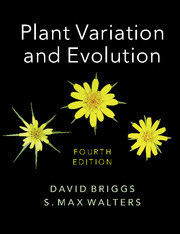Book contents
- Frontmatter
- Contents
- Preface to the Fourth Edition
- Acknowledgements
- Note on names of plants
- List of abbreviations
- 1 Investigating plant variation and evolution
- 2 From Ray to Darwin
- 3 Early work on biometry
- 4 Early work on the basis of individual variation
- 5 Post-Darwinian ideas about evolution
- 6 DNA: towards an understanding of heredity and molecular evolution
- 7 Breeding systems
- 8 Intraspecific variation and the ecotype concept
- 9 Pattern and process in plant populations
- 10 Pattern and process: factors interacting with natural selection
- 11 Populations: origins and extinctions
- 12 Species and speciation: concepts and models
- 13 Allopatric speciation and hybridisation
- 14 Abrupt speciation
- 15 The species concept
- 16 Flowering plant evolution: advances, challenges and prospects
- 17 Historical biogeography
- 18 The evolutionary impact of human activities
- 19 The taxonomic challenge ahead
- 20 Conservation: from protection to restoration and beyond
- Glossary
- References
- Index
9 - Pattern and process in plant populations
Published online by Cambridge University Press: 05 June 2016
- Frontmatter
- Contents
- Preface to the Fourth Edition
- Acknowledgements
- Note on names of plants
- List of abbreviations
- 1 Investigating plant variation and evolution
- 2 From Ray to Darwin
- 3 Early work on biometry
- 4 Early work on the basis of individual variation
- 5 Post-Darwinian ideas about evolution
- 6 DNA: towards an understanding of heredity and molecular evolution
- 7 Breeding systems
- 8 Intraspecific variation and the ecotype concept
- 9 Pattern and process in plant populations
- 10 Pattern and process: factors interacting with natural selection
- 11 Populations: origins and extinctions
- 12 Species and speciation: concepts and models
- 13 Allopatric speciation and hybridisation
- 14 Abrupt speciation
- 15 The species concept
- 16 Flowering plant evolution: advances, challenges and prospects
- 17 Historical biogeography
- 18 The evolutionary impact of human activities
- 19 The taxonomic challenge ahead
- 20 Conservation: from protection to restoration and beyond
- Glossary
- References
- Index
Summary
The word ‘population’, like so many other familiar terms, seems to present little difficulty until we have to define it. In statistics, the concept of population is an abstraction signifying a theoretically large assemblage of individuals from which a particular group under consideration is a sample. Most biological uses of the term, however, imply the total of organisms belonging to a particular taxonomic group (or ‘taxon’) that are found in a particular place at a particular time. Scientific research involves the testing of models. The population model of outstanding significance, in the study of variation, is quite specific, being the local ‘interbreeding group of individuals sharing a common gene pool’ (Dobzansky, 1935 in Rieger, Michaelis & Green, 1976). In earlier editions of this book, the term ‘gamodeme’ was used for such populations. The deme terminology was devised by Gilmour and associates (Gilmour & Gregor, 1939; Gilmour & Heslop-Harrison, 1954; Gilmour & Walters, 1963; Walters, 1989a, b, c). Details of the system are given in the glossary. It is with some regret that we abandon the use of this term, but must face the fact that the ‘-deme’ terminology has not been accepted or is used in ways not intended by its authors (Briggs & Block, 1981).
Population geneticists have coined other names – Mendelian or panmictic populations – for groups essentially similar to gamodemes. All these units represent idealised ‘model systems’ (see Maynard Smith, 1989; Silvertown & Lovett Doust, 1993; Silvertown & Charlesworth, 2001).
The model underlying the idealised population is the Hardy–Weinberg Law. In a population with two alleles A and a, which are selectively neutral and in which mating is at random, the expected frequencies of A and a (p and q respectively) are
(p + q)2 = p2 + 2pq + q2 = 1
This represents the ‘null’ model (Cockburn, 1991), for a large population of constant number in a diploid organism, with sexual reproduction, non-overlapping generations, the same allele frequencies in male and female, no gene flow or migration and no selection operating. In such a situation the relative frequencies of the alleles will not change from generation to generation.
Clearly, in natural populations ‘in the wild’, many factors will cause deviations from the Hardy–Weinberg equilibrium, and these have been modelled by population geneticists (Silvertown & Lovett Doust, 1993; Silvertown & Charlesworth, 2001).
- Type
- Chapter
- Information
- Plant Variation and Evolution , pp. 160 - 200Publisher: Cambridge University PressPrint publication year: 2016

